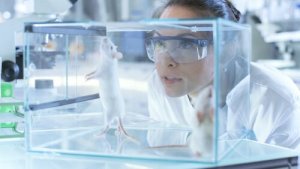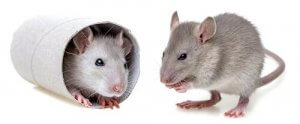Laboratory Mice: The Ideal Animal Model


Written and verified by the biologist Ana Díaz Maqueda
For over a century, humans around the world have used laboratory mice as models for medical testing and experiments. This small rodent is closely related to the house mouse (Mus musculus), an animal that has become accustomed to living in close contact with humans, whose homes provide it with both shelter and food.
Do you want to know why these animals are ideal for use in experiments? In today’s article, we’ll tell you why mice are the animal model of choice. After all, it’s thanks to these animals that scientists have made huge advances in curing serious cardiac diseases, immunodeficiency disorders, and cancer.
What are animal models?
Animal models are widely used in life sciences such as medicine or biology. In fact, humans have used animals in experiments since before the time of the Ancient Greeks, except during the middle ages when laws imposed by the Catholic church forbade the desecration of corpses.
In the past, scientists conducted experiments on both animals and humans. However, the introduction of the Nuremberg Code after the Second World War prohibited the use of human testing in the development of new drugs.
Scientists have sequenced the genomes of all animal models used in experiments, allowing researchers to extrapolate the results of one study and apply them to other animals, including humans. According to the US National Defense Research Committee, an animal model is defined as:
“A living organism in which normative biology or behavior can be studied, or in which a spontaneous or induced pathological process can be investigated, and in which the phenomenon in one or more respects resembles the same phenomenon in humans or other species of animal.”

The use of animal models allows scientists to have a greater understanding of the biology and pathophysiology of diseases which affect both humans and other animals. After all, much of the research done in laboratories can also apply itself to veterinary medicine.
Why mice?
Researchers use a huge variety of different animals in scientific experiments: mice, rats, rabbits, dogs, pigs, sheep, frogs, flies, monkeys etc. But the most used animal model of all is the mouse – in more than 50% of cases.
There are many reasons why mice are the animal model of choice:
- Being mammals, their biological processes are very similar to those of a human.
- The time between one generation of mice and the next is very short.
- They adapt easily to life in laboratory animal facilities.
- They are small and easy to handle, and don’t get easily stressed by human contact.
- Next to humans, mice are one of the mammals into which most genetic research has been done.
- There are many different strains of mice. This makes them ideal for studies of genetic mutations such as cancer.
- They are the only animal model whose stem cells have been successfully grown in vitro.
- Having studied laboratory mice for more than a century, humans now have extensive knowledge of their biology, genetics and behavior.
Thanks to lab mice, researchers have succeeded in making huge advances in the investigation of autoimmune diseases and cancer. However, it’s important to remember that these animals are sentient beings, with their own needs, and a well-defined and well-known ethology.
Laboratory mice: needs and requirements
Mice are sociable animals that naturally live in large groups. Any decision to isolate individual mice must be fully justified by researchers. Once the mice are 21 days old, scientists separate them according to sex. Otherwise, they would undoubtedly start to reproduce, creating unwanted litters.
Once these male and female groups are in place, researchers cannot remove or introduce new individuals, as it can destabilize the group hierarchy. This can lead to fights and injuries, especially when it comes to males.
Cage dimensions and the number of mice that can be kept in a single cage are stipulated by law.

Finally, mice also need environmental enrichment, such as:
- The material of the cage itself.
- Nesting material (regardless of the sex of the animal).
- Toys, which can include cardboard tubes, wooden chews, and translucent red plastic shelters. Mice can’t see red, so these shelters allow researchers to observe the animal inside without disturbing it.
- Special food such as fruit or bread.
Environmental enrichment is essential for ensuring an animal’s mental and physical health. If an animal starts to develop abnormal behaviors, it not only raises a number of serious animal welfare issues, but will mean that none of the results from the study will be valid.
For over a century, humans around the world have used laboratory mice as models for medical testing and experiments. This small rodent is closely related to the house mouse (Mus musculus), an animal that has become accustomed to living in close contact with humans, whose homes provide it with both shelter and food.
Do you want to know why these animals are ideal for use in experiments? In today’s article, we’ll tell you why mice are the animal model of choice. After all, it’s thanks to these animals that scientists have made huge advances in curing serious cardiac diseases, immunodeficiency disorders, and cancer.
What are animal models?
Animal models are widely used in life sciences such as medicine or biology. In fact, humans have used animals in experiments since before the time of the Ancient Greeks, except during the middle ages when laws imposed by the Catholic church forbade the desecration of corpses.
In the past, scientists conducted experiments on both animals and humans. However, the introduction of the Nuremberg Code after the Second World War prohibited the use of human testing in the development of new drugs.
Scientists have sequenced the genomes of all animal models used in experiments, allowing researchers to extrapolate the results of one study and apply them to other animals, including humans. According to the US National Defense Research Committee, an animal model is defined as:
“A living organism in which normative biology or behavior can be studied, or in which a spontaneous or induced pathological process can be investigated, and in which the phenomenon in one or more respects resembles the same phenomenon in humans or other species of animal.”

The use of animal models allows scientists to have a greater understanding of the biology and pathophysiology of diseases which affect both humans and other animals. After all, much of the research done in laboratories can also apply itself to veterinary medicine.
Why mice?
Researchers use a huge variety of different animals in scientific experiments: mice, rats, rabbits, dogs, pigs, sheep, frogs, flies, monkeys etc. But the most used animal model of all is the mouse – in more than 50% of cases.
There are many reasons why mice are the animal model of choice:
- Being mammals, their biological processes are very similar to those of a human.
- The time between one generation of mice and the next is very short.
- They adapt easily to life in laboratory animal facilities.
- They are small and easy to handle, and don’t get easily stressed by human contact.
- Next to humans, mice are one of the mammals into which most genetic research has been done.
- There are many different strains of mice. This makes them ideal for studies of genetic mutations such as cancer.
- They are the only animal model whose stem cells have been successfully grown in vitro.
- Having studied laboratory mice for more than a century, humans now have extensive knowledge of their biology, genetics and behavior.
Thanks to lab mice, researchers have succeeded in making huge advances in the investigation of autoimmune diseases and cancer. However, it’s important to remember that these animals are sentient beings, with their own needs, and a well-defined and well-known ethology.
Laboratory mice: needs and requirements
Mice are sociable animals that naturally live in large groups. Any decision to isolate individual mice must be fully justified by researchers. Once the mice are 21 days old, scientists separate them according to sex. Otherwise, they would undoubtedly start to reproduce, creating unwanted litters.
Once these male and female groups are in place, researchers cannot remove or introduce new individuals, as it can destabilize the group hierarchy. This can lead to fights and injuries, especially when it comes to males.
Cage dimensions and the number of mice that can be kept in a single cage are stipulated by law.

Finally, mice also need environmental enrichment, such as:
- The material of the cage itself.
- Nesting material (regardless of the sex of the animal).
- Toys, which can include cardboard tubes, wooden chews, and translucent red plastic shelters. Mice can’t see red, so these shelters allow researchers to observe the animal inside without disturbing it.
- Special food such as fruit or bread.
Environmental enrichment is essential for ensuring an animal’s mental and physical health. If an animal starts to develop abnormal behaviors, it not only raises a number of serious animal welfare issues, but will mean that none of the results from the study will be valid.
All cited sources were thoroughly reviewed by our team to ensure their quality, reliability, currency, and validity. The bibliography of this article was considered reliable and of academic or scientific accuracy.
- Benavides, F., & Guénet, J. L. (2003). Manual de genética de roedores de laboratorio. Principios básicos y aplicaciones. Madrid: Universidad de Alcalá de Henares.
- Dávila, A. G. (2008). Breve historia de la experimentación animal. Lecturas Singulares, (6).
- Real Decreto 53/2013, de 1 de febrero, por el que se establecen las normas básicas aplicables para la protección de los animales utilizados en experimentación y otros fines científicos, incluyendo la docencia
- Zúñiga, J. M., Muriana, J. O. y J. T., Marí. (2008). Ciencia y tecnología del animal de laboratorio. Sociedad Española para las Ciencias del Animal de Laboratorio (SECAL).
This text is provided for informational purposes only and does not replace consultation with a professional. If in doubt, consult your specialist.








